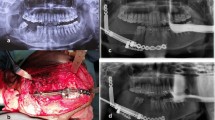Abstract
Introduction
Reconstruction of the maxilla and mandible is a complex task. The age-old options such as free bone grafts, microvascular grafts and alloplasts are associated with multiple limitations. Transport distraction osteogenesis, a relatively new mode of reconstruction, is superior to the traditional methods of reconstruction in multiple ways. It eliminates the need for a second donor site, additional soft tissue grafting, etc. In addition, it provides adequate bone height and width that allows dental rehabilitation of the patient with implants. TDO is an important tool in the armamentarium of the maxillofacial reconstruction surgeon.
Case Reports
We present a series of 21 cases of different types of transport distraction osteogenesis using indigenous transport distractors. Defects caused by congenital abnormalities, benign and malignant pathologies were treated. Indigenous stainless steel transport distraction devices were used to substantially reduce the costs involved in the procedure. Thirteen cases of bifocal TDO, one case of trifocal TDO and seven cases of alveolar distraction osteogenesis were done. 100% success rate was seen in this case series. Bone healing was monitored using ultrasonography to reduce radiation exposure. Bone formation was confirmed with the use of 3D CT scans.
Conclusion
Transport distraction osteogenesis is an effective and reliable option for the reconstruction of maxillary and mandibular defects.






Similar content being viewed by others
References
Samchukov ML, Cherkashin AM, Cope JB (2001) Craniofacial distraction osteogenesis (ed 1). St Louis, MO, Mosby, p 349
Costantino PD, Shybut G, Friedman CD et al (1990) Segmental mandibular regeneration by distraction osteogenesis—an experimental study. Arch Otolaryngol Head Neck Surg 116:535
McCarthy JG et al (1992) Lengthening the human mandible by gradual distraction. Plast Reconstr Surg 89:1–10
Zapata U, Elsalanty ME, Dechow PC, Opperman LA (2010) Biomechanical configurations of mandibular transport distraction osteogenesis devices. Tissue Eng Part B Rev 16(3):273–283. https://doi.org/10.1089/ten.teb.2009.0502
Zhang GL, Zhang M (2008) Advance on the bone transport distraction osteogenesis for the treatment of bone defects. Zhongguo Gu Shang 21(12):950–952
Neelakandan RS, Bhargava D (2012) Transport distraction osteogenesis for maxillomandibular reconstruction: current concepts and applications. J Maxillofac Oral Surg 11(3):291–299. https://doi.org/10.1007/s12663-011-0329-3
Yuhasz MM, Koch FP, Kwiatkowski A, Young C, Clune J, Travieso R, Wong K, Van Houten J, Steinbacher DM (2014) Comparing calvarial transport distraction with and without radiation and fat grafting. J Cranio-Maxillofac Surg 42(7):1412–1422
Hoffmeister B, Mracks WK (1998) The floating bone concept in intraoral mandibular distraction. J Craniomaxillofac Surg 26:76
Andrade N, Aggrawal N, Jadhav G, Sahu V, Mathai PC (2018) To determine the efficacy of ultrasonography in the evaluation of bone fill at the regenerate site for mandibular distraction osteogenesis over clinical and radiographic assessment–an in vivo prospective study. J Oral Biol Craniofac Res 89–93:2212–4268
Goldwaser BR, Papadaki ME, Kaban LB, Troulis MJ (2012) Automated continuous mandibular distraction osteogenesis: review of the literature. J Oral Maxillofac Surg 70(2):407–416. https://doi.org/10.1016/j.joms.2011.01.042
Uckan S, Senol G, Ogut E, Muftuoglu G (2018) Horizontal alveolar transport distraction osteogenesis followed by implant placement. Int J Oral Maxillofac Surg. https://doi.org/10.1016/j.ijom.2018.11.001
Funding
No funding was received.
Author information
Authors and Affiliations
Corresponding author
Ethics declarations
Conflict of interest
The authors declare that there were no competing interests during the study.
Ethical Approval
Not required as the study was retrospective in nature and all ethical norms were adhered to.
Consent to Participate
Written informed consent was obtained from all the participants of the study.
Consent for Publication
All authors consent to publish.
Additional information
Publisher's Note
Springer Nature remains neutral with regard to jurisdictional claims in published maps and institutional affiliations.
Rights and permissions
Springer Nature or its licensor (e.g. a society or other partner) holds exclusive rights to this article under a publishing agreement with the author(s) or other rightsholder(s); author self-archiving of the accepted manuscript version of this article is solely governed by the terms of such publishing agreement and applicable law.
About this article
Cite this article
Andrade, N., Mathai, P., Venkatakrishan, L. et al. Reconstruction Using Transport Distraction Osteogenesis with Indigenous Distractors: A Case Series. J. Maxillofac. Oral Surg. (2023). https://doi.org/10.1007/s12663-023-02016-0
Received:
Accepted:
Published:
DOI: https://doi.org/10.1007/s12663-023-02016-0




